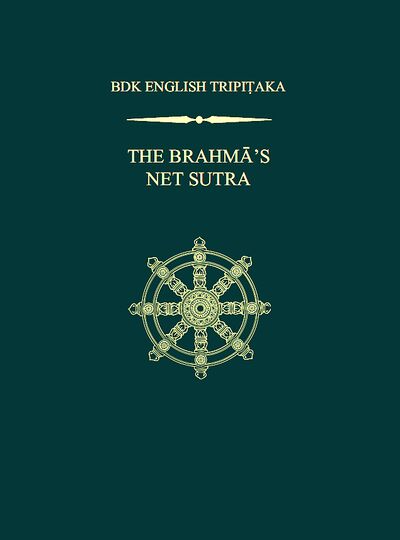- A Message on the Publication of the English Tripiṭaka, NUMATA Yehanv
- Editorial Foreword, Kenneth K. Tanakavii
- Publisher's Foreword, A. Charles Mullerix
- Translators' Introduction, A. Charles Muller and Kenneth K. Tanakaxvii
- The Brahmā's Net Sutra
- Fascicle 1. Exposition of the Brahmā's Net Sutra
- (Preface)3
- Preface to the Brahmā's Net Sutra by Śramaṇa Sengzhao3
- The Forty Stages4
- (Convocation)4
- Ten Departures for the Destination6
- Ten Nourishing Mental States6
- Ten Adamantine Mental States6
- Ten Grounds7
- The Ten Departures toward the Destination8
- 1. The Mental State of Detachment8
- 2. The Mental State of Morality8
- 3. The Mental State of Patience9
- 4. The Mental State of Zeal9
- 5. The Mental State of Concentration10
- 6. The Mental State of Insight10
- 7. The Mental State of Making Vows11
- 8. The Mental State of Guarding11
- 9. The Mental State of Joy12
- 10. The Summit Mental State12
- The Ten Nourishing Mental States13
- 1. The Mental State of Kindness13
- 2. The Mental State of Pity13
- 3. The Mental State of Joy14
- 4. The Mental State of Nonattachment14
- 5. The Mental State of Giving15
- 6. The Mental State of Caring Speech15
- 7. The Mental State of Beneficence15
- 8. The Mental State of Sameness16
- 9. The Mental State of Concentration16
- 10. The Mental State of Insight16
- The Ten Adamantine Mental States17
- 1. The Mental State of Faith17
- 2. The Mental State of Mindfulness18
- 3. The Profound Mental State18
- 4. The Mental State of Penetrating Illumination18
- 5. The Direct Mental State19
- 6. The Mental State of Nonretrogression19
- 7. The Mental State of the Great Vehicle19
- 8. The Markless Mental State20
- 9. The Mental State of Wisdom20
- 10. The Indestructible Mental State21
- The Ten Grounds21
- 1. The Ground of the Equality of the Essence21
- 2. The Ground of the Skillful Wisdom of the Essence23
- 3. The Ground of the Luminosity of the Essence25
- 4. The Ground of the Knowability of the Essence26
- 5. The Ground of the Wisdom-illumination of the Essence28
- 6. The Ground of the Floral Radiance of the Essence29
- 7. The Ground of the Completion of the Essential Nature31
- 8. The Ground of the Buddha’s Roar of the Essential Nature32
- 9. The Ground of the Flower Ornamentation of the Essence34
- 10. The Ground of Entry into the Buddha Realm of the Essential Nature35
- Fascicle 2. The Precepts
- Preface to the Bodhisattva Precepts of the Brahmā's Net Sutra37
- Invocation38
- The Teaching Transmitted to the Transformation-body Buddhas38
- Repayment of Kindness and a Separate Iteration of the Teaching39
- The Exhortation40
- The Bodhisattva Precepts41
- The Transmission and Remembrance of the Founding Teacher41
- Preface to the Formation of the Precepts42
- Interlocutor’s Preface42
- The Preface of the World-honored One42
- The Preface of the Preceptor42
- The Dharma Preface43
- The Preface for the Disciples43
- The Main Sermon43
- Introduction of the Exhortation to Uphold43
- The Ten Grave Precepts44
- 1. Prohibition of Killing for Pleasure44
- 2. Prohibition of Stealing Others’ Property44
- 3. Prohibition of the Heartless Pursuit of Lust44
- 4. Prohibition of Intentional Lying45
- 5. Prohibition of the Sale of Alcohol45
- 6. Prohibition of Speaking of the Faults of Others45
- 7. Prohibition of Praising Oneself and Disparaging Others46
- 8. Prohibition of Parsimony and Abuse of Others46
- 9. Prohibition of Holding Resentments and Not Accepting Apologies46
- 10. Prohibition of Denigration of the Three Treasures47
- Conclusion47
- The Minor Precepts48
- Division of Ten Precepts48
- Precepts Concerning the Guarding of One's Own Thoughts
- 1. Do Not Show Disrespect to Senior Teachers48
- 2. Do Not Drink Alcohol48
- Precepts Concerning the Guarding of One's Own Thoughts
- Division of Ten Precepts48


